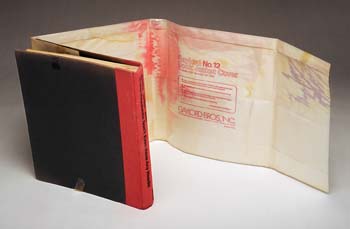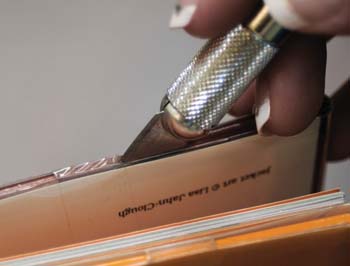Step 5: Inspect Dust Jacket – if the Book has One
 Dust jacket covers are usually made with clear plastic and paper. This protects a book’s cover from moisture damage. It can also trap moisture against the book’s dust jacket. Mold may begin growing inside the dust jacket, eventually spreading through the dust jacket cover’s paper backing to the book itself. Conversely, the dust jacket may prevent mold from transferring from the dust jacket to the book by adding another layer between the exterior of the jacket and the book itself.
Dust jacket covers are usually made with clear plastic and paper. This protects a book’s cover from moisture damage. It can also trap moisture against the book’s dust jacket. Mold may begin growing inside the dust jacket, eventually spreading through the dust jacket cover’s paper backing to the book itself. Conversely, the dust jacket may prevent mold from transferring from the dust jacket to the book by adding another layer between the exterior of the jacket and the book itself.
If in your investigation you have determined that the dust jacket needs closer inspection, this is a good time to do it:
-
 Remove the dust jacket by cutting the tape that secures it in place. Be careful not to cut the book cover or dust jacket in the process.
Remove the dust jacket by cutting the tape that secures it in place. Be careful not to cut the book cover or dust jacket in the process. - Next, remove the dust jacket from the book.
- Examine both sides of the dust jacket and the outside of the book’s cover for signs of moisture damage such as stains.
- If it is just the dust jacket that looks questionable, it is a good idea to remove the dust jacket from the cover to check whether the plastic cover or the dust jacket are still moist, or if mold is growing on the inside of the dust jacket, concealed by the paper part of the dust jacket cover.
Books Gone Bad - Mold in Library Collections was a project sponsored by Maine College of Art, in partnership with the Joanne Waxman Library. Funding for this project came from the Stephen and Tabitha King Foundation. The Project Lead and Artist for this project was Diane J. Wren. All contents Copyright © 2011 by Diane J. Wren. All rights reserved. No part of this web site may be reproduced or distributed in any form or by any means, electronic, mechanical, photocopying, recording, or otherwise, or stored in a data base or retrieval system, without the prior written permission of Diane J. Wren.